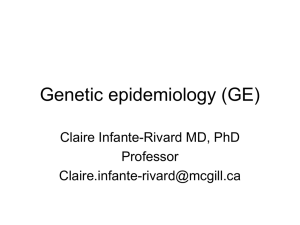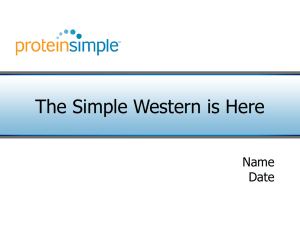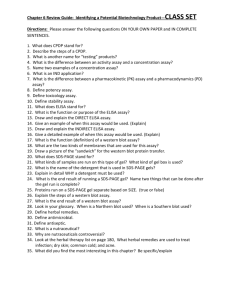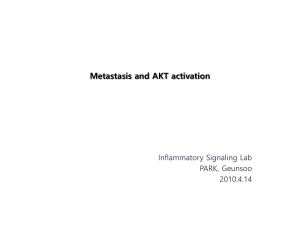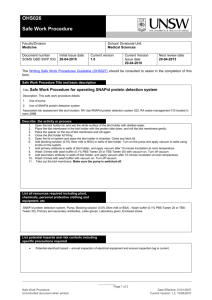Supplementary Information (docx 40K)
advertisement
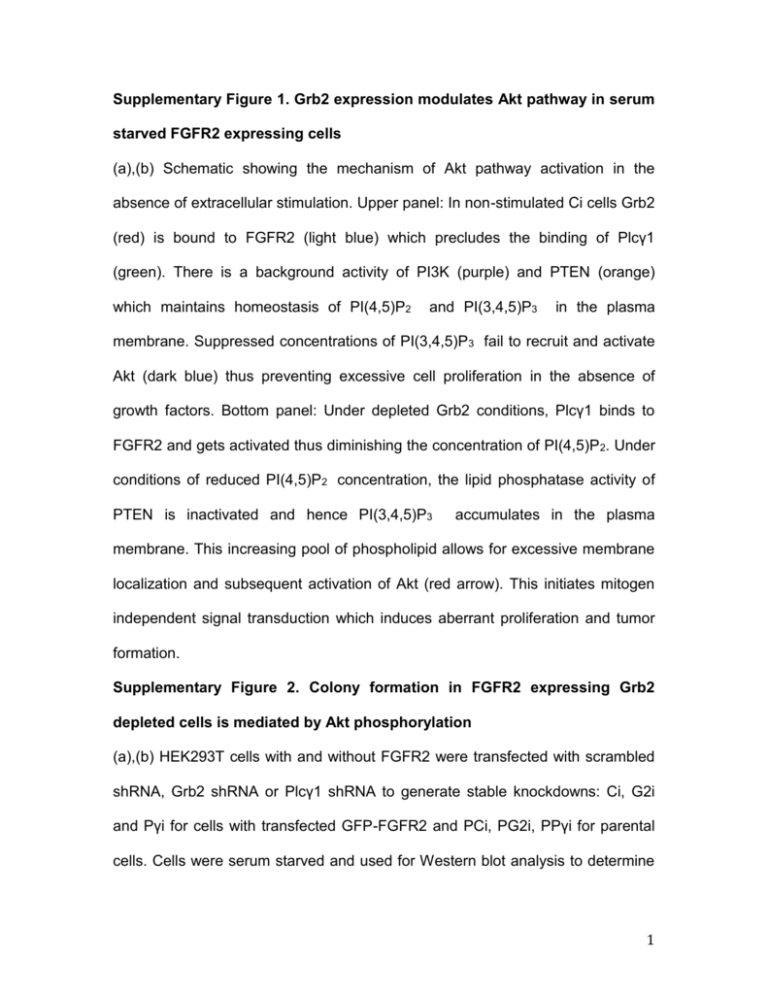
Supplementary Figure 1. Grb2 expression modulates Akt pathway in serum starved FGFR2 expressing cells (a),(b) Schematic showing the mechanism of Akt pathway activation in the absence of extracellular stimulation. Upper panel: In non-stimulated Ci cells Grb2 (red) is bound to FGFR2 (light blue) which precludes the binding of Plcγ1 (green). There is a background activity of PI3K (purple) and PTEN (orange) which maintains homeostasis of PI(4,5)P2 and PI(3,4,5)P3 in the plasma membrane. Suppressed concentrations of PI(3,4,5)P3 fail to recruit and activate Akt (dark blue) thus preventing excessive cell proliferation in the absence of growth factors. Bottom panel: Under depleted Grb2 conditions, Plcγ1 binds to FGFR2 and gets activated thus diminishing the concentration of PI(4,5)P 2. Under conditions of reduced PI(4,5)P2 concentration, the lipid phosphatase activity of PTEN is inactivated and hence PI(3,4,5)P3 accumulates in the plasma membrane. This increasing pool of phospholipid allows for excessive membrane localization and subsequent activation of Akt (red arrow). This initiates mitogen independent signal transduction which induces aberrant proliferation and tumor formation. Supplementary Figure 2. Colony formation in FGFR2 expressing Grb2 depleted cells is mediated by Akt phosphorylation (a),(b) HEK293T cells with and without FGFR2 were transfected with scrambled shRNA, Grb2 shRNA or Plcγ1 shRNA to generate stable knockdowns: Ci, G2i and Pγi for cells with transfected GFP-FGFR2 and PCi, PG2i, PPγi for parental cells. Cells were serum starved and used for Western blot analysis to determine 1 the efficiency of the knockdowns and FGFR2 expression level. Membranes were probed for the proteins shown on the blots followed by densitometric analysis. (c) Cells were treated with FGFR2 inhibitor SU5402 in serum starvation media followed by western blot analysis and probing with the relevant antibodies to detect the efficiency of the inhibition. (d) Untreated or FGF9 treated Ci and G2i cells in DMEM (no serum added) were used in colony formation assay with an incubation period of 24 hours. (e) Western blot analysis followed by densitometric analysis was utilized to test the efficiency of FGF9 stimulation in (d) using pErk as readout. (f) Western blot analysis was used to show the efficiency of the inhibitor U0126 and the effect of inhibition of MAPKK on phosphorylation of Akt S473. Ci and G2i cells were left untreated or treated with MAPKK inhibitor U0126 in serum starvation medium then lysed and probed with the indicated antibodies followed by densitometric analysis. (g) To show the efficiency of Wortmannin mediated inhibition of PI3K, untreated and Wortmannin treated Ci and G2i cells were serum starved, lysed and used for western blot analysis. The blot was then probed with the indicated antibodies followed by densitometric analysis. (h) Western blot analysis was used to show the effect of Akt inhibitor VIII on phosphorylation of Akt S473 and hence testing its efficiency. Ci and G2i cells were left untreated or treated with Akt inhibitor VIII in serum starvation medium, lysed then probed with the indicated antibodies followed by densitometric analysis. 2 (i) To show increased phosphorylation of Akt in Grb2-depleted cells, untreated and SF1670 treated Ci and G2i cells were serum starved, lysed and used for western blot analysis then probed with the antibodies for phosphorylated Akt followed by densitometric analysis. (j) RPPA heat map represents data on protein expression and phosphorylation in Ci and G2i cells (with or without FGF9). Results in Figure 1e are the normalized linear values derived from this comprehensive map. Supplementary Figure 3. PI3K activity is similar in non-stimulated Ci and G2i cells yet Akt phosphorylation increases upon Grb2 depletion (a) Ci, G2i and G2i cells with knocked in Grb2 were serum starved, lysed then used in eestern blot analysis and probed with the indicated antibodies followed by densitometric analysis. (b) ROS 17/.8 cells were transfected with scrambled shRNA (Ci) or Grb2 shRNA (G2i). These cells along with LoVo cells expressing endogenously low level of Grb2 were serum starved, lysed then used in western blot analysis and probed with the indicated antibodies followed by densitometric analysis. (c) Western blot analysis was used to show the effects of depletion of Plcγ1 on phosphorylation of Akt. Ci, G2i and Pγi cells were serum starved, lysed and probed with the indicated antibodies followed by densitometric analysis. In Plcγ1 knock down cells (Pγi), the phosphorylation of Akt is abrogated. (d) Western blot analysis was used to show the effects of knocking down Plcγ1 on Akt kinase activity in cells depleted of Plcγ1. Ci, G2i and Pγi cells were serum 3 starved, lysed and used for in vitro kinase assay as described in the Materials and Methods section. In Pγi cells the phosphorylation of GSK3α/β and hence Akt activity is reduced. (e). Competitive ELISA assay was used to determine PI3K-mediated production of PI(3,4,5)P3 in Ci and G2i cells where absorbance at 450nm is inversely proportional to the amount of lipid produced. Absorbance at 450nm was measured for PI(3,4,5)P3 standards prepared in serial dilutions along with 4 controls (blank, “no lipid” sample, “no enzyme” sample, “purified and active PI3K” sample to detect assay efficiency). (f) A standard curve was generated from the samples done in triplicates and a trend line (linear regression line) was created with the equation shown on the graph. (g) Ci and G2i cells were serum starved, left untreated or treated with Wortmannin (to ensure PI(3,4,5)P3 production is PI3K mediated). This was followed by lysis and immunoprecipitation of PI3K on agarose beads using a PI3K specific antibody. Absorbance at 450 nm was measured for samples run in triplicates. Values were averaged and error bars denote standard deviation of the mean. (h) Same as C, but in this case membrane fractions instead of total cell lysates from untreated Ci and G2i cells were utilized in the experiment. 4 Supplementary Figure 4. PI(4,5)P2 depletion is accompanied by PI(3,4,5)P3 accumulation in G2i cells (a) Ci and G2i cells were transfected with an empty mCherry vector or mCherryAkt-PH vector. Cells were serum starved, lysed and used for western blot analysis where the blots were probed with the indicated antibodies to show cellular expression levels (efficiency of transfection). (b) Cell lysates from serum starved Ci and G2i cells were used for western blot analysis where the blots were probed for pPDK1 followed by densitometric analysis. PDK1 is heavily phosphorylated only in the absence of Grb2. (c),(d),(e) Mass ELISA assays (refer to Martials and Methods section) were used to determine PI(3,4)P2, PI(4,5)P2 and PI(3,4,5)P3 levels in Ci, G2i and OVCAR3 (with and without Grb2) cells where absorbance at 450nm is inversely proportional to the amount of lipid produced. Absorbance at 450nm was measured for standards prepared in serial dilutions along with 2 controls (blank and “no lipid” samples to detect assay efficiency). Standard curves were generated from the samples done in triplicates (n=3) and trend lines were created with the equation shown on the graphs. Cells were serum starved followed by lipid extraction and ELISA assays. Absorbance at 450 nm was measured for samples run in triplicates. Values were averaged and error bars denote standard deviation of the mean. Absorbance at 450 nm was used to extrapolate the amount of lipids produced. Supplementary Figure 5. Akt phosphorylation under basal conditions is dependent on Grb2 mediated PI(3,4,5)P3 accumulation 5 (a),(b) Unlabelled FGFR2 was transfected in HEK 293T cells followed by transfection with either scrambled shRNA (Ci) or Grb2 shRNA (G2i). Cells were then transfected with either GFP-PH-Akt (for specific labelling of PI(3,4,5)P3) or GFP-PH-PLCδ (for specific labelling of PI(4,5)P2). Serum starvation, western blot analysis and subsequent probing with the indicated antibodies followed this. Numbers on the blot are the results of the densitometric analysis performed. (c) The spatial distribution of the gold particles was analyzed using univariate K function as an additional control for the sensitivity and efficiency of the assay. This allowed us to investigate whether the lipid probes are clustered or exhibit complete spatial randomness (CSR). The linear transformation of the function, L(r) – r, shows the distance r between neighboring gold particles. When the values are above the 99% confidence interval (CI) for CSR, this indicates clustering at that value of r. The plots of the weighted mean standardized univariate K functions are shown. (d) The peak value, Lmax, of the univariate K function is shown as mean±SEM in the histogram. In Ci cells unlike G2i cells, GFP-PH-Akt shows a drastic loss of clustering due to PI(3,4,5)P3 depletion. In Ci cells unlike G2i cells, GFP-PHPLCδ shows a drastic increase of clustering reflecting PI(4,5)P2 accumulation. Student’s t-test was used to assess statistical significance (**p≤ 0.01). Supplementary Figure 6. FGFR2, Grb2 and Plcγ1 are prognostic markers for ovarian cancer patient survival 6 (a) Immunoprecipitation of FGFR2 followed by western blot analysis was utilized to detect the efficiency of complex formation between the receptor and Grb2 in the indicated cell lines. (b),(c),(d),(e) Database analysis was utilized to detect the correlation between the biomarkers and patient survival as explained in the Materials and Methods section. The calculated Log-rank test value was used to determine statistical significance. Supplementary Figure 7. Original western blots (a) Figure 1f. (b) Figure 2a (upper panel), 3a. (c) Figure 2a (bottom panel), 5e. (d) Figure 2e. (e) Figure 3g. (f) Figure 4e. (g) Figure 5c. (h) Figure 5e. (i) Figure 5f. Supplementary Table: RPPA values for protein expression and phosphorylation in normalized linear value. Supplemental Experimental Procedures Reagents. Antibodies targeted against the proteins FGFR2 (C-17; sc-122), Grb2 (C-23) and anti-rabbit secondary antibody (sc-2004)) were purchased from Santa Cruz Biotechnology, Inc. Scrambled shRNA (sc-108080), Grb2 shRNA (sc- 7 29335-v) Plcγ1 shRNA (sc-29452-v) and FGFR2 inhibitor SU5402 were also purchased from Santa Cruz Biotechnology, Inc. Anti-GFP rabbit antibody (600401-215) and anti-RFP rabbit antibody (600-401-379) were purchased from Rockland Immunochemicals. Anti-phospho-PDK1 antibody (Ser241; 3438P), anti-β-actin antibody (4970S), along with anti-mouse (7076S), anti-Akt (9272S), anti-phospho-Akt (serine 473; 4060S), anti-phospho-Akt (Thr308; 9275S), antiphospho-PTEN (S380, T382 T383; 9549P), anti-phospho-GSK-3α/β (Ser21, Ser9; 9331S) anti-phospho p42/p44 MAPK (Thr202, Tyr204; 9101S), anti-Ki-67 (12075S), anti-phospho FGFR2 (Tyr 653/654; 3471S); U0126 (MEK1/2 inhibitor; 9930S) and Wortmannin (PI3K inhibitor; 9951S) were purchased from Cell Signaling Technology. 124017 InSolution™ Akt Inhibitor VIII, Isozyme-Selective, Akti-1/2 (124017) was purchased from Calbiochem. Mouse antibody against total Plcγ1 (610027) was purchased from BD Biosciences. The selection antibiotic puromycin dihydrochloride was purchased from Invitrogen. The metafectene transfection reagent was purchased from Biontex-USA. U73122 Plc inhibitor (U6756) was purchased from Sigma Aldrich. SF1670 (PTEN inhibitor; B-0350) and purified PI3K protein (P28-10H) were purchased from Echelon Biosciences. PI(4,5)P2 and phosphotidylserine (Ptdser) were purchased from Avanti Polar Lipids, Inc. γ[32P]ATP (specific radioactivity 3000 Ci\mmol) came from PerkinElmer. Fibroblast growth factor 9 (FGF9) was purchased from R&D Systems. Western blot analysis and treatments. Cultured cells were grown in 10 cm dishes, serum starved overnight. Cells were left untreated or treated with 10 8 ng/ml FGF9 for 30 minutes. In other experiments, cells were left untreated or treated with 9 µM U73122, or 1 µm Wortmannin, or 10 µM U0126 for 2 h. SF1670 and Akt Inhibitor were administered at 500 nM concentration for 30 minutes and 40 minutes respectively. Cells were lysed with Hepes lysis buffer (50 mM Hepes, pH 7.5, 1% (vol/vol) igepal-C630, 1 mg/ml bacitracin, 1 mM EDTA, 10 mM NaF, 1 mM sodium orthovanadate, 10% (vol/vol) glycerol, 50 mM NaCl, 1 mM PMSF, and Protease Inhibitor Cocktail Set III (EMD Millipore) as previously indicated30. Protein concentration was quantified at 595 nm, and 50 µg of total proteins was used for every blot. Image J software was used for quantification where the numbers on the blot presented in arbitrary units represent the ratio of the band relative to the loading control. Kinase assay. Cell lysates were collected and incubated with total Akt antibody overnight. Protein A/G Plus-Agarose (Santa Cruz Biotechnology, Inc; sc-2003) was used for immunoprecipitation experiments following the manufacturer’s instructions. Cell lysate and immobilized antibody were washed with lysis buffer 3x then suspended in 50 µl kinase buffer (Cell Signaling Technology; 9802) following its dilution to 1x. 1 µl of 10 mM ATP was added, along with 1 µl of Akt substrate (purified GSK-3 fusion protein (Cell Signaling Technology; 9237)). The reaction was terminated following 30 minutes of incubation at 30°C by adding sample loading buffer and heating the samples. 20 µl of each sample was loaded on a gel for Western blot analysis. Soft agar assay. 1 ml of 1% FBS DMEM (to maintain cell survival over prolonged incubation period of 8 days) containing 0.75% agar was used as the 9 bottom layer in a 6 well plate. 0.6 x104 of indicated cells were cast as a single cell suspension in 1 ml DMEM in the upper layer. Cells were left to grow for 8 days. 500 ml of DMEM with 1% FBS (with or without inhibitors (4 µM of U73122, 100 nM of Wortmannin, 5 µM of U0126, 150 nM of SF1670, 120 nM Akt Inhibitor VIII, 30 µM SU5402 ) was added to the wells once a week. Inhibitors were added to the underlay and overlay agar medium, as well as the liquid top layer which was initiated one day after seeding the cells. Concentrations were optimized so as to avoid cell death over the prolonged period of 8 days. Serum deprived DMEM was used in the bottom layer for the 24 hours incubation time experiment (in the presence or absence of 20 ng/ml FGF9). All experiments were performed in triplicate (n=3). Colonies were counted, and averaged. Statistical significance was determined by Student’s t-test where * is p ≤ 0.05, **p ≤ 0.01 and ***p ≤ 0.001. Pictures of the wells were captured using Gelcount Colony Counter (Oxford Optronix). RPPA analysis and heat map generation. Cell lysates (Ci and G2i cells in triplicates) were quantified by the MDACC RPPA Core Facility. Based on the technical information provided by the facility, the samples were two-fold-serially diluted for 5 dilutions and arrayed on nitrocellulose-coated slide in 11 x 11 format. Samples were probed with antibodies by the CSA amplification approach and visualized by DAB colorimetric reaction. Slides were then scanned on a flatbed scanner to produce 16-bit tiff image. Spots from tiff images were identified and the density was quantified by MicroVigene. Relative protein levels for each 10 sample were determined by interpolation of each dilution curve from the "standard curve" (supercurve) of the slide (antibody). The supercurve is constructed by a script in R written by Bioinformatics. These values (given as Log2 values) are defined as Supercurve Log2 (raw) value". All the data points were normalized for protein loading and transformed to a linear value (Figure 1E and Table S1). Fig (http://www.eisenlab.org/eisen/) S2I as was a generated hierarchical in cluster Cluster using 3.0 Pearson Correlation and a center metric. PI3K assay by thin layer chromatography. Binary mixed lipid vesicles with Ptdser as a non-phosphorylatable carrier lipid were utilized in this assay. 2 mg/ml of PI(4,5)P2 and 5 mg/ml of Ptdser were dissolved in chloroform:methanol:10 mM HCl (20:9:1). 20 µl of Ptdser and 50 µl of PI(4,5)P2 were mixed, dried, suspended in 300 µl of re-suspension buffer prior to sonication for 1 minute at 15% on ice and used as substrate lipid vesicles. Then 20 µl of PI3K buffer was added, along with 32 µl cold 2.5 mM ATP (to a final concentration of 160 µM) and 1 Ci γ[32P]ATP to prepare a complete substrate mixture. For the assay 100 µl of this substrate was mixed with 100 µl of cell lysate and incubated for 2 hours at 37°C. The reaction was quenched by adding 5 µl Ptdser. For each reaction 1 M HCl, chloroform:methanol, reaction buffer (0.5 N NaCl in 0.1 N HCl) were added in the volumes 100 µl, 900 µl, 300 µl respectively. The samples were vortexed for 5 minutes and then centrifuged for 3 minutes at 10,000g to separate the organic (bottom) and aqueous (top) phases. The upper phase containing unused 11 γ[32P]ATP was discarded and the bottom phase containing [32P]PI(3,4,5)P3 was used for TLC analysis as described in the manuscript. Lipid extraction and TLC analysis. Cell pellets were re-suspended in 0.2 ml of reaction buffer (0.5 N NaCl in 0.1 N HCl). 0.6 ml of chloroform:methanol (1:2) was added and the suspension was vigorously vortexed for 30 minutes 0.2 ml of reaction buffer was added followed by vortexing for 10 minutes. After 5 minutes of centrifugation the upper water-methanol phase was discarded and lower chloroform lipid phase was transferred to an Eppendorf tube. Lipid extracts were used in thin layer chromatography (TLC) analysis. 25,000 cpm aliquots were brought to same volume with chloroform. The phospholipids were analyzed after separation on one-dimensional TLC on potassium oxalate impregnated silica gel plates using a solvent system containing chloroform/methanol/ammonium hydroxide/water (57:50:4:11, v/v/v/v) to separate PI(4,5)P2, PI(3,5)P2 and PI(3,4,5)P3 from one another. 20 cm high-performance Partisil LK5 silica gel precoated TLC plates with a concentration-zone (Whatman Inc. Clifton, NJ) were impregnated for 1 minute in 1.2 % (w/v) potassium oxalate in methanol-water (2:3). After air drying the plates were desiccated at 100°C for 60 minutes before use. Radiolabeled lipids were visualized and quantified using a Personal Molecular ImagerTM FX (Bio-Rad Laboratories). Stored images were processed and quantified using Quantity One software for scanning and analysis of the captured Phosphor images (Bio-Rad Laboratories). Phospholipid content is expressed as mol% of total phospholipid based on the pixel intensity of the 12 captured signal on Phosphor screen generated by the radiolabeled spots on the TLC plate. PI3K assay by competitive ELISA. The assay was performed in triplicates utilizing serum starved Ci and G2i cell lysates or membrane fractions. Cells were left untreated or treated with Wortmannin and/or FGF9. The rest of the assay was carried out exactly as explained in the manufacturer’s instructions “PI3Kinase Activity ELISA: Pico 96-well ELISA Assay for Detection of PI(3,4,5)P3”; Product Number: K-1000s; Echelon Biosciences. A Western blot probing for pAkt was used to detect the efficiency of PI3K pathway inhibition. A standard curve was generated with the indicated controls and a trend line was added to help in data extrapolation. Assay was repeated 3 independent times and the results were averaged. Statistical significance was determined by Student’s t-test. Microscopy. HEK293T cells (Ci and G2i) stably expressing GFP-FGFR2 were transfected with empty mCherry vector or Akt-PH-mCherry using metafectene following the manufacturer’s instructions. The success of transfection was confirmed via Western blot analysis. Serum starved cells on glass coverslips were fixed with 4% (wt/vol) paraformaldehyde, pH 8.0 for 20 minutes when transfected with the domains. Cells were then washed with PBS and mounted onto a slide with mounting buffer (0.1% p-phenylenediamine/75% glycerol in PBS). Imaging was performed using a confocal microscope (model SP5; Leica) 13 to detect colocalization between mCherry-tagged construct and GFP used as a membrane marker to indicate membrane localization of the domain. Cell fractionation. HEK293T cells (Ci and G2i) were serum starved overnight and then washed 3x with PBS. Subcellular Protein Fractionation Kit for Cultured Cells (Thermo Scientific; product number 78840) was used according to the manufacturer’s instructions. Following protein quantification Western blot analysis was performed where FGFR2 was used as a membrane marker, and βactin as cytoplasmic marker. PI(3,4,5)P3 phosphatase assays. [Inositol-2-3H(N)] PtdIns (4,5)P2 (specific radioactivity 20 3H(N)]]PI(3,4,5)P generation of 3 32P Ci/mmol) was purchased (Perkin-Elmer). [Inositol-2- was prepared essentially as previously described for radiolabeled PI(3,4,5)P310 except that ‘hot’ PI(4,5)P3 and ‘cold’ ATP were used instead of "cold" PI(4,5)P2 and "hot" ATP. PI(4,5)P2 and phosphatidylserine (Ptdser) were prepared to a final concentration of 2 mg/l and 5 mg/ml respectively in chloroform:methanol:10 mM HCl (20:9:1). The resuspension buffer was composed of 20 mM HEPES (pH 7.5), 1 mM MgCl2 and 1 mM EGTA. The 20x kinase buffer for the PI3K kinase assay consisted of 400 mM HEPES (pH 7.8), 100 mM MgCl2 and 20 mM EGTA. For substrate preparation 16.8 µl of stock PI(4,5)P2 mixed with 1 µCi of [Inositol-2-3H(N)] PtdIns (4,5)P2 and 6 µl of stock Ptdser were mixed, evaporated and re-suspended in 500 µl resuspension buffer (20 mM HEPES (pH 7.5), 1 mM MgCl2 and 1 mM EGTA) and then sonicated for 1 minute at 15% amplitude (Digital Sonifier (Branson, USA)) 14 on ice. 18 µl H2O, 5 µl of 20x kinase buffer, 2 µl ‘cold’ ATP, 5 µl purified recombinant PI3K, 50 µl substrate were mixed and incubated at room temperature overnight. The reaction was stopped by adding 100 µl of 1M HCl, 10 µl Ptdser (made by preparing the carrier lipid at a concentration of 5 mg/ml, drying out 40 µl and then re-suspending in 400 µl re-suspension buffer and sonicating), chloroform:methanol (1:2), 0.5 M NaCl in 0.1 M HCl. The ratio of chloroform/methanol:NaCl:HCl obtained was 0.1:0.3:0.1. The reaction was vortexed and centrifuged for 5 minute at 10,000g. The bottom layer containing [Inositol-2-3H(N)] ]PI(3,4,5)P3 was dried out and re-suspended in 500 µl of lipid re-suspension buffer and sonicated for 1 minute at 15% amplitude on ice. To measure phosphatase activity, 145 µl or 55 µl of [Inositol-2-3H(N)] ]PI(3,4,5)P3 generated as described, was added to cell lysates or to purified proteins (in vitro reconstitution assay with purified PTEN/Ptdser or purified PTEN/Ptdser with 33 µM ‘cold’ PI(4,5)P2) respectively. The total reaction volume was adjusted with 20x kinase buffer. This was followed by 2 hours incubation at 37°C. The reactions were quenched by sequential addition of 1M HCl, Ptdser carrier lipid prepared as described above, chloroform:methanol (1:1), 0.5M NaCl in 0.1 M HCl. 85 µl, 40 µl, 900 µl, 300 µl respectively were used to stop reactions with the cell lysates. 55 µl, 10 µl, 450 µl, 150 µl respectively were used to stop the reactions of purified proteins. The samples were vortexed for 5 minutes and then centrifuged for 3 minutes at 10,000g to separate the organic (bottom) and aqueous (top) phases. The bottom phase was transferred to a microcentrifuge 15 tube, evaporated to approximately 50 ml volume and loaded onto oxalate-treated TLC plate. The measured ratio of radiolabeled PI(4,5)P2/PI(3,4,5)P3 reflected the PTEN activity (see below for details on lipid quantification). Thus, throughout the paper “hot” PIP3 for the phosphatase assay was generated via two methods which were followed as necessary. 1)“Cold” PI(4,5)P2 was incubated with “hot” γ[32P]ATP to phosphorylate it via the kinase PI3K into ” γ[ 32P]PI(3,4,5)P3 at position 3 (where only γ[32P]PI(3,4,5)P3 appears on the TLC and hence can be used for experimental validation and not ratio calculation). 2) “Hot” PI(4,5)P2 in the form of [Inositol-2-3H(N)] PtdIns (4,5)P2 was incubated with “cold”ATP to phosphorylate it via the kinase PI3K into “hot” [Inositol-2-3H(N)] ]PI(3,4,5)P3 to calculate the ratio of [Inositol-2-3H(N)] PtdIns (4,5)P2/[Inositol-2-3H(N)] ]PI(3,4,5)P3 . Thus on the TLC, both “hot” PIP3 and “hot” PIP2 can be detected. To keep the figures (and the text) consistent and easier to comprehend and follow, We will refer to lipids on TLC as either PI(4,5)P2/PI(3,4,5)P3 or [32P]PI(4,5)P2/[32P]PI(3,4,5)P3 and not [Inositol-2-3H(N)] PtdIns (4,5)P2/[Inositol-23H(N)] ]PI(3,4,5)P3. PI(3,4)P2, PI(4,5)P2 and PI(3,4,5)P3 mass ELISA. The assays were performed in triplicates utilizing serum starved Ci, G2i and OVCAR3 (with and without Grb2) cells. Lipids were extracted and assays were carried out exactly as explained in the kits’ manufacturer’s instructions; Product Numbers: K-3800, K-4500 and K2500 respectively ; Echelon Biosciences. Quantification was performed as explained in the “PI3K assay by competitive ELISA “ section. 16 Measurement of PI(3,4,5)P3 level in whole cells. Measurement of steady-state content of phosphatidylinositol 3,4,5-bisphosphate (PI(3,4,5)P3) was performed in [3H]myo-inositol uniformly radiolabelled cells. HEK293T cells were pre-labeled with myo-[2-3H(N)]inositol (1μCi/ml) (Perkin-Elmer) for 24 hours in inositol-free, FBS free DMEM medium then washed with PBS. After the labelling the cells were harvested, washed and subjected to lipid extraction and TLC analysis. EM-spatial mapping. Plasma membrane sheets of Ci and G2i cells prepared from HEK293T cells transfected with FGFR2 (without a GFP fluorescent tag) and transiently expressing GFP-PH-PLCδ (for specific labelling of PI(3,5)P2) or GFPPH-Akt (for specific labelling of PI(3,4,5)P3) in 1% serum were attached to EM grids, fixed with paraformaldehyde (PFA), labeled with 4.5 nm gold nanoparticles coupled to anti-GFP and embedded in uranyl acetate. The equal expression levels of each lipid probe in the cells was confirmed via Western blotting. The distribution of gold particles was imaged and digitized using a JEOL transmission EM. The coordinates and the number of the gold particles within a 1μm2 area on the intact plasma membrane sheets were calculated using ImageJ. At least 12 plasma membrane sheet images were acquired and the mean and SEM for the number of gold particles were calculated for each condition. Student’s t-test was used to assess statistical significance. This was followed with Bivariate K function analysis as explicitly explained in Zhou et al, 2014. 17 3D culture and Ki-67 staining of OVCAR 3 cells. OVCAR3 cells (with or without Grb2 transfection) were trypsinized and utilized for 3D culture in chamber slides (Fisher Scientific, catalog# 08-774-26). For this purpose, matrigel media was prepared to give a final concentration of 5% Matrigel, 0.02M Hepes, 1 mg/ml Corning Collagen I, High Concentration (Fisher Scientific, catalog#: CB354249) in 3ml media lacking FBS. From a final concentration of 5x10 4 cells per ml of matrix, 150 ul of single cell suspension were plated in each well of 8 well chamber slide. Slides were allowed to solidify for 30 minutes in a 37C incubator. 400 ul of media with 1% FBS was added on top of each well and put back in incubator overnight. The next day, colonies were counted and averaged in 4 microscopic fields. Cells were collected, fixed with 4% PFA and washed with PBS. Cells were then permeabilized in 0.5% Triton/PBS and blocked for 1 hour in PBS-T/0.2% Triton/ 0.1% BSA/ 10% FBS. Primary antibody against Ki-67 (Cell Signaling, catalog #: 9129) was added overnight at room temperature. On the next day cells were washed with PBS and incubated with secondary antibody for 1 hour then phalloidin and DAPI for 15 minutes at room temperature. Cells were washed with PBS, mounted and imaged with a confocal microscope (model SP5; Leica). Quantitative analysis was based on counting colonies/cells followed by averaging and normalization. Student’s t-test was used to assess statistical significance. IHC staining. For mouse tumor tissue and TMAs in Figure 5A, hematoxylin and eosin staining along with pAkt (serine 473) antibody staining were performed on 18 rehydrated samples followed by visualization. This was done using automated Leica Bond III- autostainer (Department of Veterinary Medicine & Surgery at MD Anderson Cancer Center). Slides were baked at 60ºC for 30 minutes then the temperature was increased to 72ºC. Slides were then rinsed 3 times with Bond Dewax followed by absolute alcohol and Bond Wash. The temperature was then increased to 100ºC, and Bond ER Solution 1 (pH 6) was applied and incubated for 30 minutes. Slides were rinsed with Bond Wash and the temperature was allowed to come down to room temperature. Anti phospho-Akt antibody (Ser473) (D9E) XP Rabbit mAb #4060 (Cell Signaling Technology) was applied at 1:50 dilution and incubated for 15 minutes at room temperature followed by rinsing with Bond Wash. Post Primary was applied and incubated for 8 minutes then slides were again rinsed with Bond Wash. Bond Polymer was applied and incubated for 8 minutes followed by rinsing with Bond Wash 2 times then distilled H2O. Peroxide Block was applied and incubated for 5 minutes then rinsed with Bond Wash 4 times then washed with distilled H2O. DAB was applied and incubated for 10 minutes then rinsed with distilled H2O 3 times. Hematoxylin was applied and incubated for 7 minutes then rinsed with Bond Wash. Slides were then removed from Leica Bond III and rinsed with distilled H2O 4 times. They were then dehydrated in graded alcohols and xylene then coverslipped with ClearMount from American MasterTech using Leica CV5030 coverslipper. As for TMA staining in Figure 5L, paraffin-embedded sections of human ovarian cancer were deparaffinized in xylene and dehydrated-rehydrated in alcohol and PBS. Antigen retrieval was performed using citrate buffer in a steamer for 30 19 minutes. After endogenous peroxide blocking and three washes with PBS, slides were blocked with 5% horse serum and 1% goat serum, incubated with either pAkt antibody (as previously described), Plcγ1 ( (D9H10) XP® Rabbit mAb #5690) (1:100), FGFR2 (1:100) or Grb2 (1:100) antibodies overnight at 4°C. Mach4 universal HRP-polymer was used for 20 minutes at room temperature and staining was developed using DAB (Grb2: 8 mins; Plcγ1: 12 mins; FGFR2: 8 mins). Hematoxylin was used to stain nuclei. Xenograft mouse model and magnetic resonance imaging (MRI). Cell lines were tested by impact IV PCR profile for MHV, MPV, MVM, Mycoplasma pulmonis, Mycoplasma species, PVM, Sendai, TMEV GDVII. All test results were negative. Injections were made subcutaneously in the right flank of the animal. After 60 days and for MRI imaging, mice were scanned on a 4.7T Biospec USR47/40 small animal imaging system (Bruker Biospin MRI, Inc., Billerica, MA) with a 35-mm linear volume resonator and 60-mm micro-imaging gradients. A three-plane FLASH imaging sequence was used to confirm animal positioning, and coronal and axial T2-weighted RARE images (TE/TR 57/3000ms, FOV 4cm x 3cm, matrix 256 x 192, RARE factor 12) were used for tumor localization and volume measurement. For tumor volume calculation a region of interest (ROI) that surrounds tumors in the axial sections (for every slice) was created in imageJ software. The area of the ROIs is described in mm2. ROI areas were then summed up and multiplied by the slice thickness (0.75 mm for all of the scans). This is the volume of tumor within the image slices. To account for the slice gap between adjacent slices (0.25 mm for all of the scans), the mean of the ROI 20 areas for each pair of adjacent slices was computed then the sum of these means is multiplied by 0.25 mm to get an estimate of the tumor volume between slices. The tumor volume estimates were then added within slices and between slices to get the total tumor volume in mm3. Tumor volumes for mice in each group (4 adult female nude mice per group) were averaged. Following imaging, mice were sacrificed, nodules were counted and tumors were weighed. Weights were averaged in each group and plotted as bar graph where the standard deviation of the mean is denoted by error bars. Half of each tumor was used for Western blot analysis and the other half for immunohistochemistry (IHC) and hematoxylin and eosin (H & E) stains. Proteins used in Western blot analysis were extracted via sonication up to 30 minutes on ice at low setting (to efficiently separate the lipid fraction found on top of protein layer). This was followed by centrifugation at 13000 rpm for 15 minutes at 4°C. The supernatant containing the proteins was transferred to a new tube. Clinical information and level2 Affymetrix (Affymetrix U133 Array Plate Set) gene expression data publicly available from the Cancer Genome Atlas Project (TCGA; http://tcga-data.nci.nih.gov/) for ovarian cancer were utilized. Clinical information and CEL (Affymetrix U133Plus2)) array files supplied with the paper Tothil et al., 2008 were also downloaded and justRMA was used to compute expression values (this method was used to confirm TCGA data analysis results). Tumors of low malignant potential and samples from patients who received chemotherapy before sample acquisition were excluded. For each cohort (TCGA, Tothill et al., 2008), correlation between the 3 markers and patient survival was 21 assessed. Patients were grouped into percentiles according to mRNA expression. The Log-rank test was employed to determine the association between mRNA expression and survival. Kaplan-Meier method was used to generate survival curves and cut-off points to significantly split (log-rank test pvalue <0.05) the samples into low/high mRNA groups were recorded. The cutoffs were chosen so as to optimally separate the patients in both data sets (smallest p-value in each of the cases). All analyses were performed in R (version 3.0.1) (http:///www.r-project.org/). The median of overall survival (OS) in months was calculated for each case as shown in parentheses. Correlation between FGFR2, Grb2 and Plcγ1 expression, pAkt level and patient survival were based on IHC staining of TMA slides (200 patients) provided by Dr. Sood. pAkt pathological score of 0 was defined as low and 1 as high. Chi square test was used to detect statistical significance of the correlation. 22

